Powered by poop and pee?
Scientists pull clean, renewable energy from human wastes
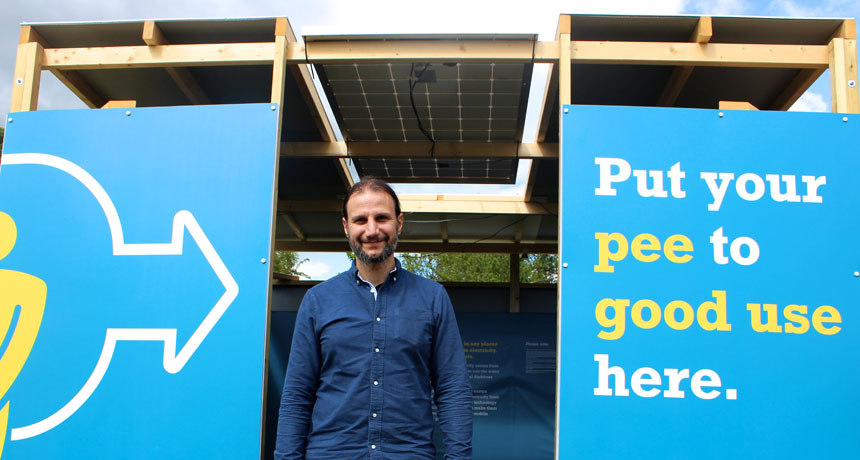
Bioengineer Ioannis Ieropoulos in the pee-powered urinal he invented. About 1,000 people a day used this urinal during the Glastonbury Music Festival.
Ioannis Ieropoulos/University of the West of England, Bristol
Flush!
Every day, people visit the toilet. Or, in developing nations, the field, pit or other location where they can relieve themselves. With more than 7 billion people on the planet, that’s a lot of waste. Mixed with water, these wastes are known as sewage. Because they host germs, they can’t just be left lying around. If they taint the water people use for eating, drinking and bathing, those germs can spread disease. So cleaning up the daiiy production of human wastes is an important part of keeping people healthy.
Most people don’t stop to think about what happens to these wastes as they get flushed down a toilet. But scientists do. Around the world, they’re doing more than just cleaning up our mess. They’re turning these wastes into the latest source of renewable energy.
People in Bristol, England, power the local bus from their trips to the toilet. In the United States, some airlines have begun using farm manure as an eco-friendly jet fuel. South Korea has a water treatment plant that uses human wastes to power itself. And people have even used pee to charge up a cell phone.
Once we get beyond the ick factor, sewage is full of energy waiting to be harnessed. And that’s why scientists are hard at work putting poop and pee to work in all sorts of ways.
Getting around town
When the GENeco Bio-Bus pulls up to a stop in Bristol, everyone knows it’s running on human waste: The bus is covered in tastefully drawn images of people sitting on toilets. Toilet wastes, along with discarded food, is used to create the gas that powers this bus. But first the end product of a good meal has to go through a series of steps before it’s ready to power people across town.
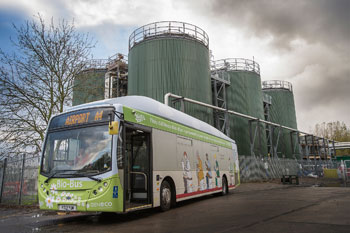
As the bacteria eat the sludge, they release gas, which is mostly methane. Methane is a greenhouse gas. Such gases help to trap heat close to Earth’s surface. Their buildup in Earth’s atmosphere has been causing global warming. But when methane is captured, it can be burned as a renewable source of energy. It’s a type of natural gas, which burns cleaner than gasoline.
The sludge-digester plant captures methane from food waste using the same process. Then it combines gases from the two sources. This mix is used to fuel up the Bio-Bus.
Homes along the route that this bus takes produce enough waste to drive the bus a whopping 4.1 million kilometers (2.5 million miles) a year, says Mohammed Saddiq. He’s the managing director of GENeco. That’s far more than is needed to run the bus. So there’s plenty left over to heat nearby homes, as well.
Letting waste do the work
A wastewater treatment plant in Ontario, Calif., captures methane using a similar process. Run by the Inland Empire Utilities Agency, this plant purifies the gas and pipes it into a fuel cell. This device converts chemical energy into electric energy. The fuel cell is heated before the gas comes in. When the biogas (gas collected from the breakdown of waste) enters the cell, it reacts with oxygen. This produces water, carbon dioxide and electricity.
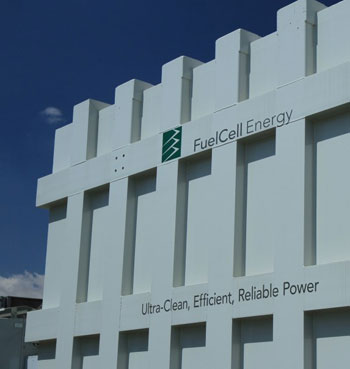
The fuel cell cuts down on the coal or other fossil fuels needed to run the plant, says Jesse Pompa. He is an engineer at Inland Empire. But in this case, the electricity the fuel cell creates doesn’t cover all of the water-treatment plant’s needs.
Such uses of biogas are common in wastewater treatment plants, says Perry McCarty. An environmental engineer, he works at Stanford University in Palo Alto, Calif. For decades, people have used anaerobic digesters to produce biogas for energy, he notes. But normally those digesters do not capture all of the energy stored in wastewater. That’s because all the waste in that water doesn’t settle out into sludge. Some is left behind.
Many wastewater treatment plants also use membrane bioreactors to treat wastewater. These systems use oxygen-breathing bacteria — or aerobes — to clean the leftover water and break down any waste that remains in it. Most of these systems don’t produce methane to generate electricity. In fact, they use electricity to add oxygen to the wastewater. That’s because the bacterial workers in this system require oxygen to break down the organic wastes in the water.
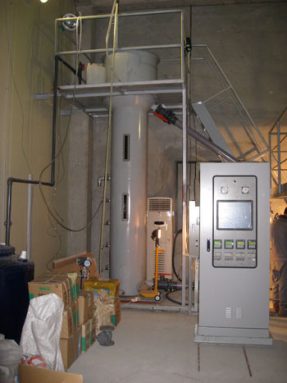
These microbes colonized the pieces of carbon, covering each one. As wastewater flowed through the bioreactor, massive numbers of bacteria chowed down on the dissolved waste particles. While doing so, they generated methane.
McCarty and his team built a treatment plant in South Korea to test the process. And it worked better than the scientists had expected. The methane produced by this system, when added to the methane produced during the anaerobic digestion of sludge, is enough to power an entire wastewater-treatment plant. So it needs no fossil fuels. And the more waste the bacteria ate, the healthier they were, making the system self-sustaining.
Electricity from pee
Methane produced by bacteria is one source of energy people can harness from human wastes. But some types of bacteria produce electricity directly. Electricity is the movement of electrons through a circuit. As bacteria break down food, some types release electrons. Lucky for us, these bacteria love to dine on the stuff we flush down the toilet.
At the University of the West of England in Bristol, Ioannis Ieropoulos puts these bacteria to work. As a bioengineer, he uses living organisms to solve engineering problems. He grows the microbes on a mesh made from carbon fibers. There they form a biofilm.
Now, the engineers pipe in urine. As the bacteria chomp down on the organic matter in this liquid waste, they release electrons. These negatively charged particles then travel through the carbon mesh to wires. Such electricity-producing set-ups are known as microbial fuel cells. They provide electricity and can clean up wastewater.
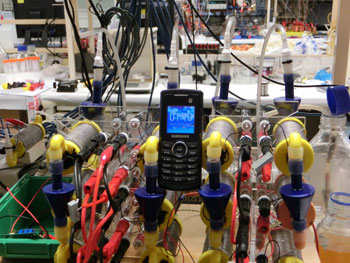
Ieropoulos and his team have been working to make the fuel cells smaller and easier to carry. One goal is to have these fuel cells create enough electricity to power the lights in refugee camp tents and buildings. So far, the researchers have built many small units (each holds just 6.25 milliliters, or 0.2 ounces, of urine). Then they stack them up. The engineers have shown that a stack of 40 microbial fuel cells can charge up a cell phone battery. They also have used the fuel cells to light up bathrooms. Using 288 stacked fuel cells, the scientists powered the lights in a urinal on the Bristol campus. It took 432 to power a urinal that was used about 1,000 times a day at the nearby Glastonbury Music Festival.
The bacterial workers in these fuel cells are remarkably resilient, says Ieropoulos. Once they form a biofilm, they can last about 3 weeks without anyone stopping to visit the toilet and provide them with additional food. And when someone does, the bacteria jump to immediate action, generating electricity.
Ieropoulos is currently developing the technology so that it can be used pretty much anywhere. “We want to be able to drop it into a hole in the slums,” he says. There, it will clean wastewater, improving public health. At the same time, it could provide electricity for people who currently lack it.
Feeding a bacterial battery
Back at Stanford, environmental engineer Craig Criddle is also putting electron-producing bacteria to work. His team has created a microbial battery. Similar to the microbial fuel cell, bacteria inside his team’s new battery grow on carbon filaments.
They attach themselves to the filaments using nanowires. These tiny strings hold the bacteria in place. They also act as electrical wires to carry electrons away from the microbes.
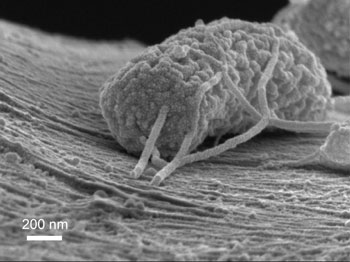
The microbial battery captures energy from waste more efficiently than a microbial fuel cell can. In the fuel cell, energy is lost when some electrons react with oxygen and hydrogen to make water, Criddle explains. But in the microbial battery, the electrons are transferred to an electrode that prevents such reactions from occurring. When the electrode fills up with electrons, the battery stops working. But the researchers simply remove the electrode, releasing the excess electrons into the air. When reinserted in the microbial battery, electrons flow freely and the battery goes back to work.
Like McCarty’s bioreactor, these batteries could be used to capture energy from dissolved particles in wastewater. Or they could be powered by food wastes. For example, manufacturers of fruit juice or soda might use these batteries to clean the water left over from making and bottling those drinks, Criddle says. At the same time, these batteries could provide power for the factory.
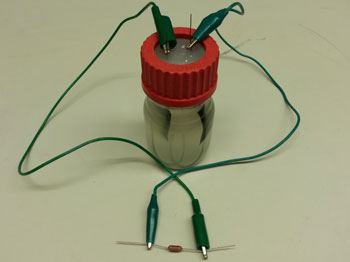
Mention powering lighting or laptops with pee or poop and most people shudder. They see the germy, smelly wastes, not the resources they hold. Indeed, there’s energy gold in those wastes. And fortunately, cadres of non-squeamish engineers are willing to harness them as a sustainable source of fuel or power.
Power Words
(for more about Power Words, click here)
activated carbon Charcoal that has been treated in a way that increases its ability to absorb chemicals.
aerobic Occurring in the presence of oxygen. Aerobic reactions take place in locations with access to oxygen.
anaerobe An organism able to live in the absence of oxygen.
anaerobic Occurring in the absence of oxygen. Anaerobic reactions take place in oxygen-free locations.
anaerobic digester A structure used to break down solid material found in sewage. Bacteria the thrive in an oxygen-free environment eat the organic material, releasing methane gas.
anode The negative terminal of a battery, and the positively charged electrode in an electrolytic cell. It attracts negatively charged particles.
bacterium (plural bacteria) A single-celled organism. These dwell nearly everywhere on Earth, from the bottom of the sea to inside animals.
battery A device that can convert chemical energy into electrical energy.
bioengineer Someone who applies engineering to solve problems in biology or in systems that will use living organisms.
bioengineering The application of technology for the beneficial manipulation of living things. Researchers in this field use the principles of biology and the techniques of engineering to design organisms or products that can mimic, replace or augment the chemical or physical processes present in existing organisms. This field includes researchers who genetically modify organisms, including microbes. It also includes researchers who design medical devices such as artificial hearts and artificial limbs.
biofilm A gooey community of different types of microbes that essentially glues itself to some solid surface. Living in a biofilm is one way microbes protect themselves from stressful agents (such as poisons) in their environment.
carbon The chemical element having the atomic number 6. It is the physical basis of all life on Earth. Carbon exists freely as graphite and diamond. It is an important part of coal, limestone and petroleum, and is capable of self-bonding, chemically, to form an enormous number of chemically, biologically and commercially important molecules.
climate change Long-term, significant change in the climate of Earth. It can happen naturally or in response to human activities, including the burning of fossil fuels and clearing of forests.
carbon dioxide A colorless, odorless gas produced by all animals when the oxygen they inhale reacts with the carbon-rich foods that they’ve eaten. Carbon dioxide also is released when organic matter (including fossil fuels like oil or gas) is burned. Carbon dioxide acts as a greenhouse gas, trapping heat in Earth’s atmosphere. Plants convert carbon dioxide into oxygen during photosynthesis, the process they use to make their own food.
digest (noun: digestion) To break down food into simple compounds that the body can absorb and use for growth. Some sewage-treatment plants harness microbes to digest — or degrade — wastes so that the breakdown products can be recycled for use elsewhere in the environment.
electricity A flow of charge, usually from the movement of negatively charged particles, called electrons.
electron A negatively charged particle, usually found orbiting the outer regions of an atom; also, the carrier of electricity within solids.
environment The sum of all of the things that exist around some organism or the process and the condition those things create for that organism or process. Environment may refer to the weather and ecosystem in which some animal lives, or, perhaps, the temperature, humidity and placement of components in some electronics system or product.
environmental engineer A person who uses science to study and improve the natural environment.
fossil fuel Any fuel — such as coal, petroleum (crude oil) or natural gas — that has developed in the Earth over millions of years from the decayed remains of bacteria, plants or animals.
fuel cell A device that converts chemical energy into electrical energy. The most common fuel is hydrogen, which emits only water vapor as a byproduct.
greenhouse gas A gas that contributes to the greenhouse effect by absorbing heat. Methane is one example of a greenhouse gas.
methane A hydrocarbon with the chemical formula CH4 (meaning there are four hydrogen atoms bound to one carbon atom). It’s a natural constituent of what’s known as natural gas. It’s also emitted by decomposing plant material in wetlands and is belched out by cows and other ruminant livestock. From a climate perspective, methane is 20 times more potent than carbon dioxide is in trapping heat in Earth’s atmosphere, making it a very important greenhouse gas.
microbe Short for microorganism. A living thing that is too small to see with the unaided eye, including bacteria, some fungi and many other organisms such as amoebas. Most consist of a single cell.
microbial fuel cell A device that relies on microbes to initiate a chemical reaction to generate electricity. These devices can use waste materials, including sewage and manure, to produce energy cleanly. (see also fuel cell)
nano A prefix indicating a billionth. In the metric system of measurements, it’s often used as an abbreviation to refer to objects that are a billionth of a meter long or in diameter.
nanowire A wire or rod on the order of a billionth of a meter in cross-section or in circumference. It is usually made from some type of semiconducting material. However some bacteria make string-like anchoring structures on the same size scale. Like the semiconductor wire, the bacterial ones also can transport electrons.
natural gas A mix of gases that developed underground, like crude oil (and often in association with crude oil) over, millions of years. Most natural gas starts out as 50 to 90 percent methane, along with small amounts of heavier hydrocarbons, such as propane and butane.
organic (in chemistry) An adjective that indicates something is carbon-containing; a term that relates to the chemicals that make up living organisms.
particle A minute amount of something.
renewable energy Energy from a source that is not depleted by use, such as hydropower (water), wind power or solar power.
sewage Wastes — primarily urine and feces — that are mixed with water and flushed away from homes through a system of pipes for disposal in the environment (sometimes after being treated in a big water-treatment plant).
sustainability (adj: sustainable) To use resources in a way that they will continue to be available in the future.
waste Any materials that are left over from biological or other systems that have no value, so they can be disposed of as trash or recycled for some new use.
wastewater Any water that has been used for some purpose (such as cleaning) and no longer is clean or safe enough for use without some type of treatment. Examples include the water that goes down the kitchen sink or bathtub or water that has been used in manufacturing some product, such as a dyed fabric.
Word Find (click here to enlarge for printing)








